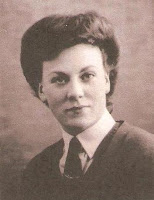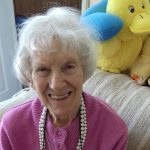
During World War Two I served in the WAAFs1 from 1942 to 1946 as a motor transport driver. After demob and enjoying a variety of jobs for a couple of years, I migrated to Australia in 1958 as a Ten Pound Pom2. I worked my way round the capital cities until on a holiday from my job in Melbourne I joined a safari in the Northern Territory where I met a crocodile hunter. I married him and together we set up a non-safari style tourist venture in the region. Ten years later, in 1974, I took time off to fly back to England to catch up with English relatives. I stayed with my sister and brother-in-law in Cambridge and they lent me their car to go wartime memory hunting.
I couldn’t wait to drive to RAF Bourn to see once again the aerodrome where I had been stationed in 1944 as driver attached to 105 Pathfinder Squadron. My job was mainly taking the Mosquito3 aircrew to and from the various dispersal points when they were on ops or test flights. There was very little left of the airfield I knew. I stood on the site of the Squadron Flight Offices, which were now no more than a crumbling block of concrete, and imagined hearing again the scrabbling of bicycles against the outer walls as the air crews reported for briefing. I could almost hear the AFN4 radio playing Glen Miller’s signature tune Moonlight Serenade which usually coincided with evening briefing time, and the shuffling of the crews in their thick, lambs-wool-lined flying boots as they went up and down the passageway past our drivers’ rest room. I recalled sitting in our vehicles, sometimes on freezing winter nights, waiting for the first faint sound of the returning aircraft, so that we could dash to dispersal to pick up the crews when they returned – if they returned.
-

Bourne Airfield, 2014
I drove down to the old WAAF quarters but they had almost vanished under a ploughed field. However, I found the wrecked Sergeant’s Mess and scrunched over broken glass, old teacups, and caved in walls, trying to imagine it as it had once been. Another car drew up beside mine where I’d parked it on the roadway that used to run through the middle of the aerodrome. A young man got out and approached me with a brochure of some sort in his hands. “Hello,” he smiled, “are you a farmer, too, and interested in this land? It’s not a bad piece but one would have to clear all those awful old buildings out of the way first.” Blankly I mumbled “No, er, I’m just sort of looking, trying to remember a few things.” “Oh, you looked like you might be thinking of buying.” “No,” I explained, “it’s just that I’ve come over from Australia on holiday and I’m catching up on a few old memories. I was a WAAF stationed here in the last war.” “Oh, that,” he said, dismissing the war as completely inconsequential. “Well, give my love to Down Under and all that”, and he got in his car and drove off with a friendly wave. I was stunned. How could anyone treat this land which had seen so much sorrow in such a cavalier fashion?
I got back into the car and sat there a moment as memories came flooding in. I thought of the Australian aircrew I had known, one of them the crack Queensland pilot, Bill Blessing, who was killed in ML964 over Caen. And I remembered dancing with English pilot George Whiffen at a NAAFI5 dance the night he joined the Squadron. He could talk of nothing but his new wife called Doreen. Sadly he went out on his first raid a few nights later in ML913 and never came back.
I thought of Pat Enderby in MM134 swinging on take-off after losing an engine one day on a test flight, and crashing into a barn next to the WAAF quarters. I happened to be nearby and joined a group of WAAFs desperately trying to make a chain and pass buckets of water from the Ablutions Block to douse the fire. An ambulance and fire engine were quickly on the scene but it was all too late to save Pat. And I thought of Alec Lickley, and his navigator, Johnnie Cameron, who one night after a raid on enemy territory, got badly shot up and only just managed to get back across the English coast. Their Mosquito, ML987, ended up in pieces in an orchard but miraculously they lived to fight another day. By the time I left the airfield I was quite ragged with grief after bringing back to mind not only those I have just mentioned, but so many more names and the crashes and the death toll.
I didn’t see the airfield again until some 40 years later when I left tropical Australia to retire in a somewhat cooler England. I now live in Cambourne, a new town built close by the old RAF Bourn. What is left of the airfield is now used by the Rural Flying Club and I often see and hear their single-engine aircraft fly overhead on a training flight. The sound brings back memories of those gallant men who once flew there and gave their lives. I salute them. May they never be forgotten!
By Judy
Born in London in 1924, my upbringing and education by governesses and select schools were probably typical for certain families of that period which followed the end of the First World War. When war broke out again in 1939 I left school without having passed my exams and lived for a while in Narborough helping out in the apple orchards. In 1942 I joined WAAFs (Women’s Auxiliary Air Force) as a motor transport driver. After training, I was based first at RAF Marham in Norfolk, and in 1944 was posted to RAF Bourn where I drove aircrew of a Mosquito Squadron to and from their kites when on ops. I was demobbed in 1946, a year after VE Day and I returned to Narborough, taking weekly trips to London for singing lessons. Using the name Rose Ash I had a stint on the stage as a chorus girl in the touring company of the musical comedy Annie Get Your Gun. I became third understudy for the part of Annie Oakley and when the star, Barbara Shotter, suddenly became ill on the opening night at the Liverpool Empire Theatre, played the part as the other understudies were also ill.
I loved my stage days but decided I wanted to see more of the world and joined a group travelling to India on a rickety old bus. From there I intended flying over to Australia. Unfortunately, I picked up some nasty complaint en route and had to return to England to recover. Fit again, I became a Ten Pound Pom and, in 1958, I sailed away from Tilbury Docks on the Orient Liner ‘Orontes.’ For two years I hitch-hiked in Australia ending up in Darwin from where I intended flying back to England to start off again in another direction. However, as a last fling, I went on a Safari and met one of the crocodile hunters, called Tom, who worked for the camp.
I married him and we set up our own very primitive ventures for travellers to the area. No bitumen anywhere-just rough tracks on which wild buffaloes were likely to hinder one’s journey. We progressed over the years until the bitumen and civilisation came to the area and we retired to a now modern Darwin city. Sadly, Tom took ill and died shortly after and, with a sudden hankering for the education I had missed out in my childhood, I applied to the newly opened Northern Territory University(later to become Charles Darwin University) and was accepted on probation. Amazingly I went through all the stages of Bachelor of Arts ending with my doctorate in 2008. After so many adventures in my life, I decided to write my autobiography called An English Rose in Kakadu which was published. At which point I felt a hankering to return to my family in England.
I now live in a beautiful Retirement Home called Cavendish Court in a new town called Cambourne built on the edge of the wartime airfield RAF Bourn, where I had been stationed. My days are always full, going through old papers, playing on my keyboard, writing short stories or poems and enjoying visits from the family or walking(with my stroller) around the garden with its birds singing merrily or through the nearby woods. But suddenly the world has been hit by the corona virus and life for everyone is on the verge of chaos and collapse.
Footnotes
- Women’s Auxiliary Air Force was formed in 1939 when another world war became imminent
- Ten Pound Poms referred to a scheme for migration to Australia after World War II. “Pom” meant British people
- British long range fighter-bomber
- American Forces Network
- Navy, Army and Air Force Institutes

I have just come across the post by Judith Opitz from 2014. My name is Rachael Maggs and my mum is George and Doreen Whiffen's daughter, the pilot of ML913 that flew from Bourn on 5th July 1944.
My mum was 18 months old when George died (I obviously never met him) and her brother nearly 3 yrs old. It would be lovely if Judith has any further memories of George as my daughter (who would have been George's great-grand- daughter) is working in a school project about rant involvement in WW2. Obviously there is quite a story surrounding George!
Also I am trying to locate the 105 squadron memorial at Bourne (I live not too far away). Is it easy to find? Do you happen to know how one goes about visiting it?
Any information and memories would be such a delight to receive for our family to we would appreciate anything you could share.
This comment has been removed by the author.
Please send in your questions to taptibr@gmail.com and they will be forwarded to Judy. She will be happy to answer them. Thank you for your interest. Editor
Fascinating story. I'd love to ask some more questions to Judy, is there an email address?
Thank you for this brilliant, touching writing which brings the story of Bourn Airfield to life.